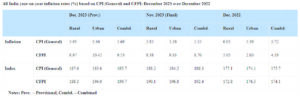
In the recent release by the National Statistical Office (NSO), Ministry of Statistics and Programme Implementation (MoSPI), the All India Consumer Price Index (CPI) on Base 2012=100 and the corresponding Consumer Food Price Index (CFPI) for Rural (R), Urban (U), and Combined (C) for December 2023 were disclosed. This press note also includes the CPIs for Sub-Groups and Groups for both All India and all States/UTs, offering a comprehensive overview of the inflation scenario.
Retail Inflation Overview
The month of December 2023 witnessed a four-month high in retail inflation, standing at 5.69%. This surge has been primarily attributed to the escalation in food prices, marking a significant economic development that warrants a closer examination.
Data Collection Process
The NSO collected price data from a robust sample, including 1114 urban markets and 1181 villages across all States/UTs. This meticulous data collection involved personal visits by field staff from the Field Operations Division of NSO, MoSPI, on a weekly roster. During December 2023, the NSO achieved an impressive coverage of 99.9% in villages and 98.6% in urban markets. The market-wise prices reported were 90.0% for rural areas and 93.7% for urban areas, ensuring a representative dataset for analysis.
Key Factors Influencing Retail Inflation
1. Food Price Dynamics
The primary driver behind the surge in retail inflation has been the substantial increase in food prices. Understanding the factors contributing to this surge is crucial for policymakers and economists. Analysis of individual food items and categories can provide insights into the specific areas influencing inflation.
2. Supply Chain Disruptions
Examining the supply chain disruptions, especially in the context of the ongoing global challenges, can shed light on how these disruptions might have contributed to the inflationary pressures. Issues such as transportation bottlenecks, supply chain delays, and global commodity price fluctuations could be key contributors.
3. Rural-Urban Disparities
The differential impact of inflation in rural and urban areas is noteworthy. While rural markets reported a coverage of 90.0%, the urban market coverage was 93.7%. Understanding the reasons behind these variations can help formulate targeted policies to address specific economic challenges in each setting.
4. Policy Implications
Policymakers need to carefully analyze the inflation data to make informed decisions. The insights gained from this data can guide the formulation of monetary and fiscal policies aimed at stabilizing prices, ensuring economic growth, and mitigating the impact on vulnerable sections of the population.
5. Global Economic Context
Assessing the global economic context and its influence on domestic inflation is imperative. External factors, such as international commodity prices, trade dynamics, and geopolitical events, can significantly impact the inflationary trends in the country.
6. Consumer Spending Patterns
An exploration of consumer spending patterns, especially in the wake of economic uncertainties, can provide valuable insights. Changes in consumer behavior, preferences, and purchasing power can directly influence inflation dynamics.
The surge in retail inflation to a four-month high in December 2023, driven by food prices, underscores the need for a comprehensive understanding of the underlying factors. Policymakers, economists, and analysts must delve into the data to formulate effective strategies for managing inflation, ensuring economic stability, and promoting inclusive growth.
As the nation navigates through these economic challenges, informed decision-making based on robust data analysis becomes paramount for sustaining a resilient and thriving economy.























